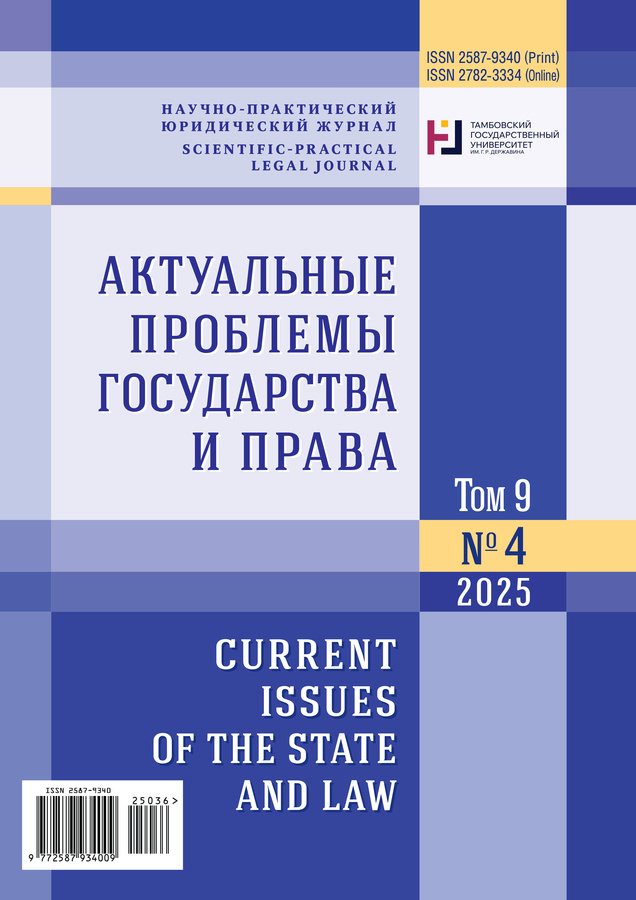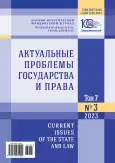Проект учреждения объединенного типа по положениям Концепции развития УИС до 2030 года
- Авторы: ЦАРЕВА Е.А.1
-
Учреждения:
- ФКОУ ВО «Кузбасский институт Федеральной службы исполнения наказаний России»
- Выпуск: Том 7, № 3 (2023)
- Страницы: 458-464
- Раздел: Обзор законодательной и правоприменительной практики
- URL: https://journal-vniispk.ru/2587-9340/article/view/303519
- ID: 303519
Цитировать
Полный текст
Аннотация
В целях реализации норм Концепции развития уголовно-исполнительной системы Российской Федерации до 2030 г. о создании учреждений объединенного типа предпринята попытка разработки модели подобного исправительного учреждения. В исследовании рассмотрен вопрос, касающийся создания правовых и организационных основ функционирования учреждения объединенного типа. Для закрепления на правовом уровне какого-либо явления прежде всего должна быть создана теоретическая модель, предложено ее научное обоснование. При этом и в национальном уголовно-исполнительном законодательстве, и в зарубежном уже присутствуют элементы предлагаемой Концепцией развития УИС модели учреждений объединенного типа. На законодательном уровне РФ предусмотрено изменение вида исправительного учреждения либо увеличивая объем прав и свобод осужденного, либо уменьшая. Статистические данные подтверждают практическую реализацию данных институтов, в связи с чем прослеживается необходимость наличия участков колонии-поселения и тюрьмы в составе проектной модели учреждения объединенного типа. Модель учреждения объединенного типа могла бы быть дополнена исправительными колониями без выделения их режимов, но с выделением условий отбывания наказания внутри одной исправительной колонии. Также в предложенной модели следует предусмотреть помещение следственного изолятора, что позволит обеспечить последовательный исправительный процесс работы с лицами, совершившими преступление. Что касается создания участка для несовершеннолетних осужденных, вызывает сомнение. Поскольку специфичность спецконтингента в виде несовершеннолетних осужденных предполагает отдельное содержание от взрослых осужденных. Наиболее оптимальной представляется идея о едином комплексе исправительных учреждений для лиц, совершивших преступление до достижения ими восемнадцатилетнего возраста, представляющим собой соединение на одной территории следственного изолятора, воспитательной и исправительной колоний. Модель учреждения объединенного типа может структурно быть представлена следующим образом: помещение следственного изолятора; исправительная колония; помещение в режиме тюрьмы; участок колонии-поселения.
Об авторах
Елена Александровна ЦАРЕВА
ФКОУ ВО «Кузбасский институт Федеральной службы исполнения наказаний России»
Автор, ответственный за переписку.
Email: kadaneva_elena@mail.ru
ORCID iD: 0009-0003-0338-0133
кандидат юридических наук, начальник кафедры организации охраны и конвоирования в УИС
Россия, Российская Федерация, Кемеровская область, 654066, г. Новокузнецк, проспект Октябрьский, 49Список литературы
- Дмитриев А.Л. Концепция УИС 2030 – доктринальный НПА // Современная юриспруденция: теория, методология, практика: материалы Междунар. науч.-практ. конф. / под общ. ред. В.В. Соловьевой. Воронеж: Наука-Юнипресс, 2022. С. 192-197. https://elibrary.ru/okkxbz
- Сироткина М.Л. Особенности создания и развития учреждений уголовно-исполнительной системы объединенного типа // Актуальные вопросы информатизации Федеральной службы исполнения наказаний: сб. материалов IV круглого стола, посвящ. 100-летию со дня рожд. Владимира Савельевича Харичева. Тверь: Науч.-исслед. ин-т информац. технологий Федеральной службы исполнения наказаний, 2022. С. 196-203. https://elibrary.ru/pncptj
- Усеев Р.З. Перспективы развития системы гибридных исправительных учреждений в аспекте обеспечения безопасности уголовно-исполнительной системы // Ведомости уголовно-исполнительной системы. 2017. № 4 (179). С. 30-35. https://elibrary.ru/wbjded
- Горбань Д.В., Южанин В.Е. Комплексные исправительные учреждения: какими они должны быть // Вестник Кузбасского института. 2022. № 2 (51). С. 20-35. https://doi.org/10.53993/2078-3914/2022/2(51)/20-35, https://elibrary.ru/irzzle
- Селиверстов В.И., Посмаков П.Н. Концептуальные и организационные основы создания объединенных (многофункциональных) исправительных учреждений // Безопасность бизнеса. 2021. № 4. С. 59-64. https://doi.org/10.18572/2072-3644-2021-4-59-64, https://elibrary.ru/fwrznm
- Уткин В.А. «Мультирежимные» исправительные учреждения: реальность и перспективы // Вестник Кузбасского института. 2014. № 21. С. 9-18. https://elibrary.ru/syjrsn
- Уткин В.А. Проблемы теории уголовных наказаний: курс лекций. Томск: Изд. Дом Томск. гос. ун-та, 2018. 240 с.
- Савонов Р.М. Тюрьма как вид исправительного учреждения и особенности режимов содержания в ней осужденных // Закон. Право. Государство. 2020. № 4-1 (28). С. 316-321. https://elibrary.ru/yvunxj
Дополнительные файлы










